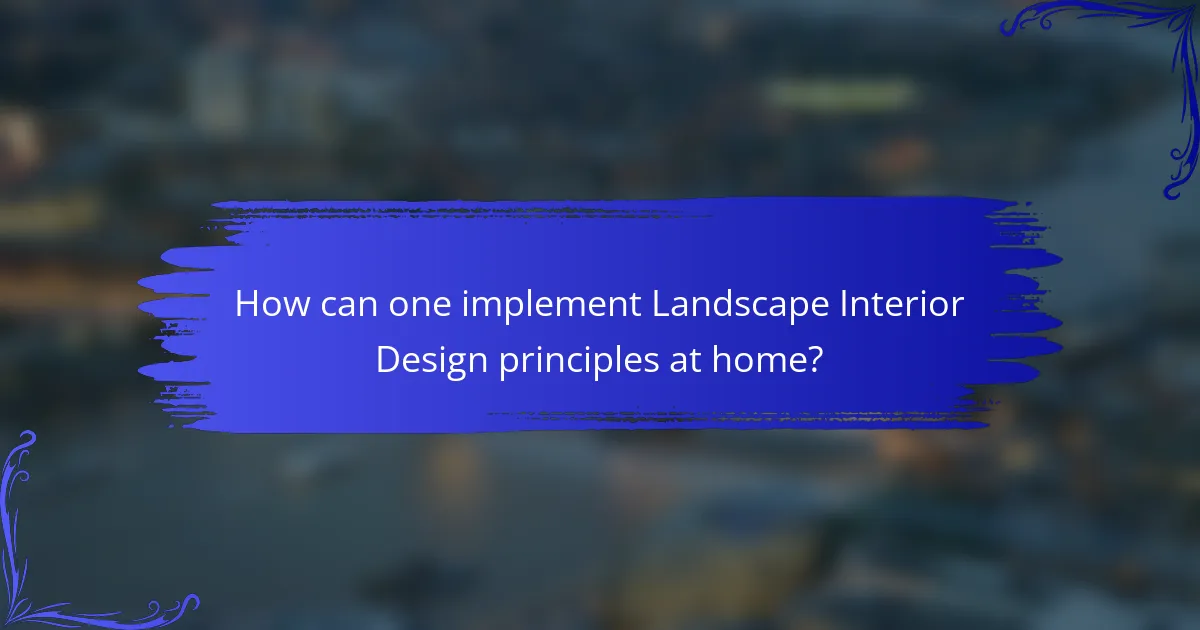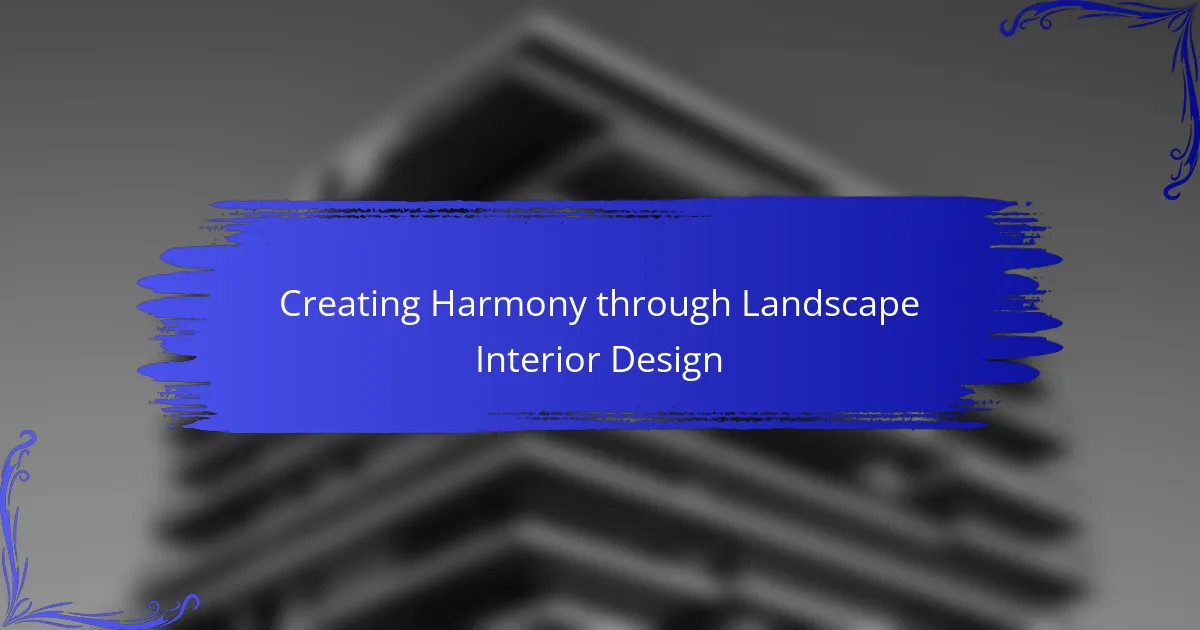Landscape interior design is the integration of indoor and outdoor spaces, focusing on creating seamless transitions between the interior environment and surrounding landscapes. This design discipline incorporates elements such as plants, hardscapes, water features, and lighting to enhance aesthetic appeal and functionality. Key benefits include increased property value and improved well-being, as nature-infused spaces are linked to reduced stress and enhanced mood. Effective implementation of landscape interior design principles involves using natural elements, selecting complementary furniture, maximizing natural light, and creating tranquil zones that mimic outdoor settings. This approach emphasizes sustainability and ecological balance in design choices.

What is Landscape Interior Design?
Landscape interior design is the practice of integrating indoor and outdoor spaces. This design discipline focuses on creating a seamless transition between the interior environment and the surrounding landscape. It involves elements such as plants, natural materials, and outdoor furniture. The goal is to enhance aesthetic appeal and improve functionality. Effective landscape interior design can increase property value and promote well-being. Studies indicate that nature-infused spaces contribute to reduced stress and improved mood. This approach emphasizes sustainability and ecological balance in design choices.
How does Landscape Interior Design contribute to creating harmony?
Landscape Interior Design contributes to creating harmony by integrating natural elements with architectural features. This approach fosters a balanced environment that promotes well-being. By using plants, water features, and materials that resonate with the surroundings, designers create cohesive spaces. The strategic placement of greenery can soften hard surfaces and enhance visual appeal. Studies show that natural elements reduce stress and improve mood. For instance, a research by Kaplan and Kaplan highlights that green spaces increase feelings of tranquility. Therefore, Landscape Interior Design effectively aligns aesthetics with nature, resulting in harmonious living spaces.
What are the key principles of Landscape Interior Design?
The key principles of Landscape Interior Design include balance, unity, scale, proportion, and rhythm. Balance refers to the distribution of visual weight in a space. Unity ensures all elements work together cohesively. Scale relates to the size of objects in relation to each other and the space. Proportion focuses on the relationship between the parts and the whole. Rhythm creates a sense of movement through repetition of elements. These principles guide designers in creating harmonious and functional landscapes.
How do elements of nature influence Landscape Interior Design?
Elements of nature significantly influence landscape interior design by integrating natural features into indoor spaces. Natural light enhances the ambiance and mood of a space. The use of plants brings life and color, improving air quality. Water elements, like fountains, create soothing sounds and visual appeal. Textures found in nature, such as stone and wood, add warmth and authenticity. Colors inspired by nature promote tranquility and balance. Seasonal changes in natural elements can inspire design updates, keeping spaces dynamic. Studies show that biophilic design, which incorporates nature, can enhance well-being and productivity in indoor environments.
Why is harmony important in Landscape Interior Design?
Harmony is important in Landscape Interior Design because it creates a cohesive visual experience. A harmonious design integrates various elements such as plants, materials, and structures. This integration enhances aesthetic appeal and promotes a sense of tranquility. Studies show that harmonious environments can reduce stress and improve well-being. For example, research published in the Journal of Environmental Psychology indicates that people feel more relaxed in spaces with balanced design elements. Therefore, harmony plays a crucial role in the effectiveness of landscape interior design.
What psychological benefits does harmony provide in interior spaces?
Harmony in interior spaces promotes psychological well-being. It reduces stress and anxiety levels. A balanced environment fosters feelings of comfort and safety. Studies show that harmonious spaces enhance mood and productivity. Colors, textures, and layouts contribute to this effect. For example, natural elements in design can improve focus and creativity. Research indicates that harmonious settings can lower cortisol levels, associated with stress. Overall, harmony in design creates a positive mental state.
How does harmony impact the overall aesthetic of a design?
Harmony significantly enhances the overall aesthetic of a design. It creates a sense of balance and unity among various elements. When design components are harmonious, they work together cohesively. This cohesion makes the design visually appealing and inviting. Harmony can be achieved through color schemes, shapes, and textures that complement each other. Research indicates that harmonious designs can evoke positive emotional responses from viewers. For example, studies show that spaces designed with harmony can reduce stress and promote well-being. Therefore, harmony is essential for achieving an aesthetically pleasing and functional design.

What are the main components of Landscape Interior Design?
The main components of Landscape Interior Design include plants, hardscapes, water features, and lighting. Plants provide natural beauty and enhance air quality. Hardscapes, such as patios and walkways, create functional outdoor spaces. Water features, like fountains or ponds, add tranquility and visual interest. Lighting highlights design elements and extends usability into the evening. These components work together to create a harmonious and inviting environment. Each element contributes to the overall aesthetic and functionality of the landscape.
How do plants and greenery enhance interior spaces?
Plants and greenery enhance interior spaces by improving air quality and aesthetic appeal. They absorb carbon dioxide and release oxygen, promoting a healthier environment. Studies show that indoor plants can reduce airborne pollutants by up to 87% within 24 hours. Greenery also adds color and texture, creating a more inviting atmosphere. Biophilic design principles suggest that incorporating nature into interiors can reduce stress and increase productivity. Research by the University of Exeter found that plants in workplaces can improve employee well-being and performance by 15%. Additionally, plants can help regulate humidity levels, contributing to overall comfort.
What types of plants are best for indoor landscapes?
The best types of plants for indoor landscapes include peace lilies, snake plants, and pothos. Peace lilies thrive in low light and improve air quality. Snake plants are resilient and require minimal watering. Pothos are versatile and can adapt to various light conditions. Other suitable plants are spider plants, which are known for their air-purifying abilities, and ZZ plants, which tolerate neglect. These plants enhance indoor aesthetics and contribute to a healthier environment.
How do plants improve air quality in interior environments?
Plants improve air quality in interior environments by filtering pollutants and producing oxygen. They absorb carbon dioxide and release oxygen through photosynthesis. Certain plants can remove volatile organic compounds (VOCs) like formaldehyde and benzene from the air. According to a study by NASA, plants can reduce indoor air pollution by up to 87% within 24 hours. Additionally, plants increase humidity levels, which can reduce dust and respiratory issues. They also contribute to psychological well-being, which can enhance overall air quality perception. Overall, incorporating plants into interior spaces significantly enhances air quality and promotes a healthier environment.
What role does lighting play in Landscape Interior Design?
Lighting plays a crucial role in Landscape Interior Design by enhancing aesthetics and functionality. It defines spaces and highlights architectural features. Proper lighting creates ambiance and mood, influencing how spaces are perceived. It also emphasizes textures and colors in landscape elements. For instance, strategic placement of lights can draw attention to plants or water features. Additionally, lighting improves safety and visibility in outdoor areas. Studies show that well-lit environments can enhance user experience and satisfaction. Thus, lighting is essential for creating harmony in landscape interior design.
How can natural light be utilized effectively in designs?
Natural light can be utilized effectively in designs by maximizing window placements and using reflective surfaces. Strategic window placement allows for optimal sunlight exposure throughout the day. This enhances mood and reduces the need for artificial lighting. Reflective surfaces, such as mirrors and light-colored walls, can amplify natural light. They help distribute light evenly across spaces. Incorporating skylights also brings in additional natural light. This is especially beneficial in areas with limited wall space for windows. Utilizing open floor plans can facilitate light flow between rooms. Studies show that natural light improves productivity and well-being.
What types of artificial lighting complement landscape elements?
Types of artificial lighting that complement landscape elements include path lights, spotlights, and floodlights. Path lights illuminate walkways and guide visitors through the landscape. Spotlights highlight specific features such as trees, sculptures, or architectural elements. Floodlights provide broad illumination for larger areas, enhancing safety and visibility. Additionally, string lights create a warm, inviting atmosphere for outdoor gatherings. Each type of lighting serves to enhance the aesthetic appeal and functionality of landscape elements. Proper placement and selection of these lighting types can significantly enhance the overall design and harmony of outdoor spaces.

How can one implement Landscape Interior Design principles at home?
To implement Landscape Interior Design principles at home, start by integrating natural elements into your space. Use plants to create a connection with nature. Select furniture that complements organic shapes and materials. Incorporate natural light through windows or skylights to enhance the ambiance. Use earthy colors for walls and decor to evoke a sense of tranquility. Create zones within your space that mimic outdoor landscapes, such as seating areas resembling garden nooks. Add water features like small fountains for a soothing effect. Incorporate textures like stone or wood to evoke a natural feel. These principles promote harmony and well-being in the home environment.
What are some practical tips for creating harmony in interior landscapes?
To create harmony in interior landscapes, focus on balance, color, and texture. Balance can be achieved through symmetrical arrangements of plants and furniture. Use a cohesive color palette to unify the space. Choose plants that complement each other in color and size. Incorporate various textures to add depth, such as smooth leaves paired with rough bark. Lighting plays a crucial role; ensure natural light is maximized and consider using soft artificial lighting. Consistent design elements, like matching pots or planters, enhance visual coherence. Finally, maintain a clean layout to avoid clutter, which disrupts harmony.
How can color schemes enhance the harmony of a space?
Color schemes enhance the harmony of a space by creating a cohesive visual experience. They influence mood and perception through the psychological effects of colors. For example, blue tones can evoke calmness, while warm colors like red can stimulate energy. A well-planned color palette can unify different elements in a room, making it feel more organized. Studies show that harmonious color schemes can increase comfort and satisfaction in a space. According to research by the Institute for Color Research, color can increase brand recognition by up to 80%. Thus, effective use of color schemes is essential in landscape interior design for achieving harmony.
What design elements should be avoided to maintain harmony?
To maintain harmony in landscape interior design, avoid clashing colors. Clashing colors can create visual discord and disrupt the overall aesthetic. Additionally, steer clear of overly complex patterns. Complex patterns can overwhelm the senses and detract from a cohesive look. Avoid mismatched furniture styles as well. Mismatched styles can lead to a disjointed environment. Lastly, refrain from using excessive decorative elements. Too many decorations can create clutter and reduce visual clarity.
What common challenges might arise in Landscape Interior Design?
Common challenges in landscape interior design include site limitations, environmental factors, and budget constraints. Site limitations may involve irregular shapes, poor soil quality, or existing structures. These factors can restrict design options and plant selection. Environmental factors such as climate and sunlight affect plant growth and sustainability. Budget constraints often limit material choices and design complexity. Additionally, achieving harmony between indoor and outdoor spaces can be difficult. Designers must balance aesthetics with functionality to create cohesive environments. Communication with clients is also crucial. Misunderstandings can lead to dissatisfaction with the final design.
How can one address issues of space limitations?
To address issues of space limitations, one can utilize multifunctional furniture. This type of furniture serves more than one purpose, maximizing utility in small areas. For example, a sofa bed provides seating and sleeping space. Vertical storage solutions also help in optimizing limited floor space. Shelves and cabinets that extend upwards utilize wall space effectively. Incorporating mirrors can create an illusion of depth, making a room feel larger. Additionally, decluttering regularly keeps spaces open and manageable. Color choices can also influence perception; lighter shades often make spaces appear more expansive. These strategies are widely recognized in interior design for enhancing functionality in compact environments.
What solutions exist for maintaining plant health indoors?
Solutions for maintaining plant health indoors include proper lighting, humidity control, and regular watering. Adequate light is essential for photosynthesis. Most indoor plants thrive in bright, indirect light. Humidity levels can be increased using humidifiers or pebble trays. Regular watering prevents over-drying or root rot. Soil quality is also crucial; use well-draining potting mix. Fertilization with balanced nutrients supports growth. Pest management through monitoring and natural remedies is important. These methods collectively enhance indoor plant vitality and longevity.
What best practices should be followed in Landscape Interior Design?
Best practices in Landscape Interior Design include understanding the site’s context, selecting appropriate plants, and creating balance. Understanding the site’s context involves analyzing climate, topography, and existing structures. Selecting appropriate plants ensures they thrive in the local environment and contribute to biodiversity. Creating balance means distributing visual weight evenly across the landscape. Incorporating pathways and focal points enhances navigation and draws attention to key areas. Using sustainable materials promotes environmental responsibility in design. Proper maintenance planning is essential for long-term aesthetics and health of the landscape. These practices lead to a harmonious and functional outdoor space that complements the interior design.
Landscape Interior Design is the integration of indoor and outdoor spaces aimed at creating a seamless transition that enhances aesthetic appeal and functionality. This article explores the principles of harmony in design, emphasizing the psychological benefits of natural elements, such as plants and lighting, in promoting well-being. Key components include balance, unity, and the effective use of color schemes to achieve a cohesive visual experience. Additionally, practical tips for implementing these principles at home and addressing common challenges in maintaining harmony are discussed.
